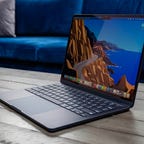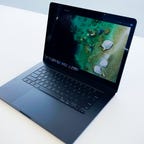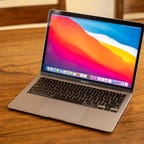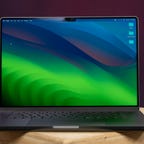Best MacBook for 2024
With M2 and M3 versions of the MacBook Air and M3 Pro and Max versions of the MacBook Pro, it can be hard to choose. Our experts will help you find the right MacBook.
What to consider
Price
Size and display
Processor
Graphics
Memory
Storage
Our Picks
What is the best overall MacBook?
The 13-inch M3 MacBook Air isn't just the best overall MacBook, it's our pick for the best overall laptop. It's our favorite because it offers stellar performance from Apple's M3 processor, along with long battery life and a design that works for a wide range of users. And we feel that Apple's MacOS is more intuitive and easier to use than Microsoft Windows.
The M3 MacBook Air's 13.6-inch display sits in the sweet spot of providing enough screen space for getting things done while remaining eminently portable, and it's available in a 15-inch size if you want a larger screen and don't want to pay the up-charge for a MacBook Pro.
The 13-inch M3 Air has a starting price of $1,099 -- $100 more than the M2 version from Apple. And students can always pick one up from Apple with an educational discount for as little as $999. The 15-inch M3 Air starts at $1,199 at Apple. The older 13-inch MacBook Air with Apple's first M1 chip is also a great buy for $699 at Walmart for students and others with tight budgets.
At CNET, we test all kinds of laptops -- from budget models for everyday tasks to high-performance laptops for gaming and content creation to everything in between. We've been reviewing MacBooks since the very first polycarbonate MacBook appeared, way back in 2006 -- and Apple's PowerBooks and iBooks before that. Each member of our team has decades of experience testing and reviewing laptops. We conduct performance testing under controlled conditions in the CNET Labs and via extensive hands-on use. This helps us find not only the best laptop overall but also the best laptop for your needs and in your price range.
Best MacBooks of 2024
For Apple's latest MacBook Air, little has changed from its predecessor beyond a move from Apple's M2 silicon to M3 chips. The performance differences are overall modest, but graphics performance does get a notable bump. The biggest feature additions are faster Wi-Fi 6E support and the capability to run dual external displays, albeit at the cost of having the Air's lid closed. Still, since Apple gave the M2 MacBook Air (our previous best overall laptop pick) the full update treatment, the fact the M3 version is nearly the same except for faster performance doesn't bother us in the slightest -- it's just that much better. And if you're still rocking an Intel-based Air or an M1 Air, the M3 MacBook Air is a worthy upgrade.
The M3 Air starts at $1,099 at Apple, and discounts at Amazon can save you between $50 and $100 on it.
Best big-screen, budget MacBook
M3 MacBook Air (15-inch 2024)
The 15-inch MacBook Air is proof that you don't need a Pro to get a larger display. It supplies a larger screen previously found only on the pricier Pro models. If you're eyeing the 14- or 16-inch Pro models primarily for the added screen size, the Air 15 is the more affordable option you should go for.
The roomy, 15.3-inch display is powered by Apple's M3 chip and 8GB of RAM. It also supplies a Touch ID sensor, two USB-C/Thunderbolt ports, a MagSafe charger and lengthy battery life. There's also a built-in 1080p camera for FaceTime calls and a three-mic array and six speakers for spatial audio support. It's available in the same four color options as its smaller, 13.6-inch sibling.
The baseline 256GB model costs $1,299 at Apple, and we've seen it on sale for $1,204 at Amazon. The 512GB model starts at $1,499 and has been discounted to as low as $1,389.
We have tested the 15-inch MacBook Air with the M3 chip and are working on the full review; look for it soon. In the meantime, you can read our review of the previous M2 version that's very similar to the M3 update.
Best budget MacBook
M1 MacBook Air (13-inch, 2020)
This model has been surpassed, but not replaced, by the newer M2 and M3 models. But now it's available at Walmart for $699, which is a hefty $300 less than its original price. It's also $300 less than the M2 Air and $400 less than the M3 model.
For many years, this Apple laptop was everyone's favorite laptop. It was reasonably priced, thin, light and built like a tank. It could last for years and take lots of falls and bumps. You get only two Thunderbolt 3 USB-C ports, but for most people that's enough, as long as you can get a whatever-to-USB-C dongle. It's a great pick for students looking for a speedy and stylish do-it-all laptop.
Best MacBook for creatives
M3 Pro MacBook Pro (16-inch, 2023)
Apple's latest update of its 16-inch MacBook Pro delivers M3, M3 Pro and M3 Max processors along with a new space black color. The screen is also slightly brighter, moving from a rated 500 nits up to 600 nits compared with the previous M2 version. Other than the new color option, the design remains largely unchanged from the previous version, but under the hood the new M3 Pro chip offers better overall performance and, in particular, big gains in multicore and rendering performance. Battery life is strong, too.
Like the previous series, the 16-inch MacBook Pro with the M3 Pro processor starts at $2,499 at Apple and can frequently be found for $200 off at Best Buy. The M3 Max model starts at $3,499. It's our Editors' Choice for graphics pros and creators for its excellent combination of design, performance and battery life.
Factors to consider when buying a MacBook
The first fork in the road you'll come to when shopping for a MacBook is whether to follow the Air path or head down the Pro road. For most people looking for an everyday home laptop or a work laptop for running basic office apps, a MacBook Air will suffice. An Air is also the better pick for students on tight budgets. For creative types who need the added processing and graphics muscle of Apple's new M3 Pro and Max chips, a MacBook Pro is worth the added cost. To help you find the right MacBook for your needs and budget, here are the main considerations to keep in mind.
Price
The entry price for a MacBook is $699. That gets you the M1 MacBook Air that was released in 2020. That offer is exclusive to Walmart. If you are shopping at Apple, pricing starts at $999 for the M2 MacBook Air and $1,099 for the current M3 Pro MacBook Air. Stepping up to a MacBook Pro model with an M3 chip will cost you $1,999 or more, but you can get a less powerful 14-inch M3 MacBook Pro for $1,599. Here are the starting prices of Apple's current MacBook lineup:
- 13-inch M1 MacBook Air: $699
- 13-inch M2 MacBook Air: $999
- 13-inch M3 MacBook Air: $1,099
- 15-inch M3 MacBook Air: $1,299
- 14-inch M3 MacBook Pro: $1,599
- 14-inch M3 Pro MacBook Pro: $1,999
- 16-inch M3 Pro MacBook Pro: $2,499
Size and display
If you'll be taking your MacBook with you to class or work or just down to your local coffee shop most mornings, an Air is the better choice. The 13-inch MacBook Air models weigh less than 3 pounds, and the roomier 15-inch Air weighs only 3.3 pounds, which is lighter than the 14-inch MacBook Pro.
The flip side to portability is screen size. The 16-inch MacBook Pro gives you ample room on which to work and multitask, while the 14-inch MacBook Pro tries to hit the sweet spot between roomy display and travel ease. Unless you need Pro-level performance, we feel the 15-inch Air does a better job of hitting that target.
- 13.3-inch M1 MacBook Air: 13.3-inch display (2,560x1,600 pixels), 2.8 pounds
- 13.6-inch M2 MacBook Air: 13.6-inch display (2,560x1,664 pixels), 2.7 pounds
- 13.6-inch M3 MacBook Air: 13.6-inch display (2,560x1,664 pixels), 2.7 pounds
- 15.3-inch M3 MacBook Air: 15.3-inch display (2,880x1,864 pixels), 3.3 pounds
- 14.2-inch M3 MacBook Pro: 14.2-inch display (3,024x1,964 pixels), 3.4 pounds
- 14.2-inch M3 Pro MacBook Pro: 14.2-inch display (3,024x1,964 pixels), 3.5 pounds
- 16.2-inch M3 Pro MacBook Pro: 16.2-inch display (3,456x2,234 pixels), 4.7 pounds
Processor
The processor, aka the CPU, is the brains of a laptop. MacBooks have used Apple's own processors since the introduction of the M1 processor in 2020. The M1-based MacBooks were clear improvements over Apple's preceding Intel-based machines in terms of overall performance, efficiency and battery life. The M1 MacBooks were more powerful with longer runtimes while also operating more coolly and quietly.
The latest MacBook Air and Pro models feature the M3 processor. The M3 MacBook Air models offer slightly better performance than the M2-based versions but not nearly to the degree of going from Intel CPUs to the M1.
Graphics
The graphics processor, or GPU, handles all the work of driving the screen and generating what gets displayed, as well as speeding up a lot of graphics-related (and increasingly, AI-related) operations. Apple's M1 and M2 CPUs integrate the GPU. The more processing cores the GPU has, the better the graphics performance. Here's the breakdown:
- M1: 7-core or 8-core GPU
- M2: 8-core or 10-core GPU
- M3: 10-core GPU
- M3 Pro: 14-core or 18-core GPU
- M3 Max: 30-core or 40-core GPU
Memory
Memory, or RAM, is where the operating system stores all the data for currently running applications, and it can fill up fast. After that, it starts swapping between RAM and SSD, which is slower. MacBook Air models start at 8GB of RAM along with the 14-inch M3 MacBook Pro. The minimum on the M3 Pro or M3 Max MacBook Pros is 18GB. If you buy from Apple, you can configure the laptop with more memory -- up to 16GB or 24GB on MacBook Airs and up to 128GB on the M3 Pro and Max MacBook Pros.
You can't upgrade the memory on recent MacBooks post purchase, so you'll need to get the RAM you need up front. MacBooks are able to smoothly run MacOS and the preinstalled apps with the minimum RAM offered, but doubling the RAM will make your MacBook feel faster and likely lead to a longer useful life of the product.
Storage
MacBooks feature solid-state drives, or SSDs. MacBook Air models start with a 256GB SSD, and MacBook Pros offer a 512GB SSD at minimum. If you use cloud storage for your files, music collection and photo library, then you might be able to get away with a 256GB SSD without filling it up before too long. We were happy to see the 13-inch MacBook Pro with its paltry 256GB SSD go away; Pro users need 512GB at the very least.
How we test laptops
The review process for laptops consists of two parts: performance testing under controlled conditions in the CNET Labs and extensive hands-on use by our reviewers. This includes evaluating a device's aesthetics, ergonomics and features with respect to price. A final review verdict is a combination of both objective and subjective judgments.
Our benchmark tests consist of a core set we run on every compatible system, including several we can run on both MacOS and Windows PCs. There's also an extended set of tests for specific use cases, such as gaming or content creation, where systems may have more-powerful GPUs or higher-resolution displays that need to be evaluated.
For the hands-on, the reviewer uses the laptop for their work during the review period, evaluating how well the design, features (such as the screen, camera and speakers) and manufacturer-supplied software operate as a cohesive whole. We also place importance on how well everything works given the cost, and where the manufacturer has potentially made upgrades or trade-offs for the price.
The list of benchmarking software and comparison criteria we use changes over time as the devices we test evolve. You can find a more detailed description of our test methodology on our How We Test Computers page.
Other laptops we've tested
Dell Inspiron 14 Plus 7440: For a reasonable $1,000, this 14-inch Dell model based on an Intel Core Ultra CPU lets you be productive and remain portable
Alienware m16 R2: This middle-class option for mainstreaming gaming fares better than average and is a sensible option for 1440p play.
Acer Predator Triton 14: With fast performance and a bright HDR screen, this mainstream 14-inch gaming laptop can be a great gaming value..
M3 MacBook Air 13: Apple's 2024 MacBook Air update is a straightforward performance boost to power you through the future of work, school and play at home or away.
Lenovo LOQ 15: Lenovo's entry-level model is the opposite of flashy, but it's got good performance and it's one of the cheapest RTX 4050 models (at least on sale).
HP Victus 16: It’s speedy and svelte, but gamers on tight budgets deserve more than this laptop's basic 60Hz panel.
Acer Nitro 16: With a roomy 16-inch, 16:10 display that's surprisingly bright and vibrant and powered by a full-octane RTX 4050 GPU, the Nitro 16 delivers the goods for gamers on tight budgets.
Acer Predator Helios Neo 16: The Helios Neo 16 is essentially a gussied-up version of the Acer Nitro 16. It just so happens to also have ample 3D performance for its budget-friendly price.
MSI Cyborg 15: It's one of the lowest-cost RTX 4050 laptops, but the Cyborg 15's GPU is restricted from running at full power, which puts a cap on 3D performance. And its display disappoints, too.
Asus ROG Zephyrus G14: Standout profiling and calibration for its class makes Asus' first OLED in the line stand out from the crowd.
Lenovo ThinkPad Z13 Gen 2: It breaks with the ThinkPad tradition in many ways without abandoning the things that make it a ThinkPad.
Lenovo ThinkPad X1 Yoga Gen 8: This 14-inch two-in-one for business users is compact for easy travel yet big enough to get work done, but Lenovo's display options for it miss the mark.
Acer Swift Go 14 (2024): Intel's new Core Ultra CPU gives this unassuming 14-inch laptop great battery life and a bit of a speed boost -- with potential AI acceleration down the road.
MSI Modern 14 C13M: Its audio-visual output won't wow you, but MSI's 14-inch budget offering boasts good build quality and competitive performance.
HP Dragonfly G4: HP's compact premium business laptop stands out with its unusual 3:2 display and unique dual-webcam capability.
Acer Swift Edge 16 (2023): It's the rare 16-inch laptop that weighs less than 3 pounds. And the OLED display is awesome.
Dell XPS 13 Plus (2023): An unconventional ultraportable gets a minor update.
Lenovo ThinkPad X1 Carbon Gen 11: The latest X1 Carbon gets 13th-gen Intel processors and greener construction but is otherwise unchanged and remains a top pick for business travelers.







